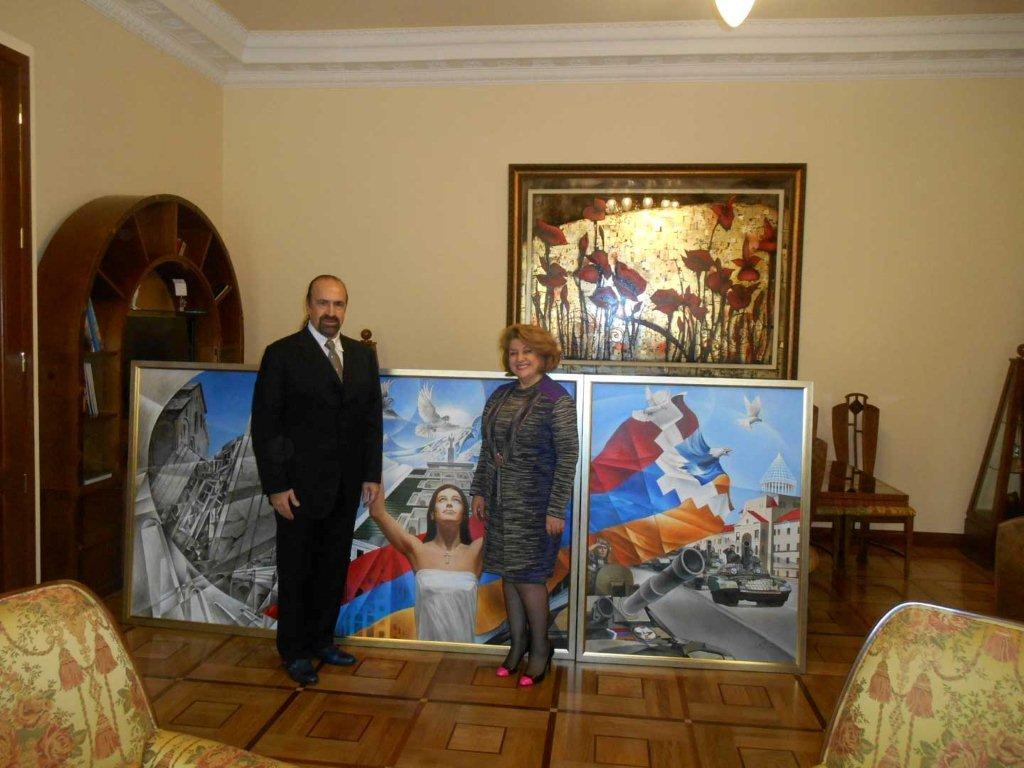YEREVAN—Artist Daniel Varoujan Hejinian of Chelmsford, Mass., is not one to sit idle very long, not when his heritage is at stake.
Weeks after his annual billboard blitz throughout Greater Boston and watching the monument he designed dedicated in Lowell, off he went to Yerevan for a personal exhibit at the National Gallery of Armenia.
Called “Peace of Art” (www.peaceofart.org), the exhibition was part of the 5th Armenia-Diaspora Conference organized by the Republic Ministry of Diaspora and dedicated to the 23rd anniversary of Armenian independence and to the Armenian Genocide Centennial in 2015.
Some 2,000 guests piled into the National Gallery to view the artist’s work, including Prime Minister Hovik Abrahamyan, Diaspora Minister Hranush Hakobyan, leaders and representatives of Diasporan Armenian organizations, public and political figures, as well as artists of every kind.
According to Hejinian, it was a cultural infusion that left viewers with an indelible impression.
“I’m truly grateful for having this opportunity to exhibit some of my best work in a country where my passion exists,” said Hejinian. “The people here were most receptive. Everywhere I went, hospitality followed. The honor truly lies with all those who made this moment become a reality.”

Pieces of artwork ‘From Genocide to Independence’ representing Hejinian’s exhibit that took place in Armenia this fall.
For openers, Hejinian was welcomed to the Presidential Palace by First Lady Rita Sargsyan where he donated a three-paneled painting (triptych) titled, “From Genocide to Independence.” Other contributions were made to the National Gallery, Ministry of Diaspora, and Ministry of Culture.
Hejinian was presented the prestigious Arshile Gorky Medal by Hakobyan as a token of appreciation.
Karen Aghamyan, president of the Union of Artists of Armenia, granted an honorary membership certificate to the artist.

Artist Daniel Varoujan Hejinian is presented the Arshile Gorky Medal from Diasporan Minister Hranush Hakobyan.
Hejinian’s portrait later graced the cover of Elite Life Magazine published in Armenia, together with more photos and an extensive story inside.
Three showrooms inside the gallery housed the exhibit, featuring 61 works of art in all. The array included 40 graphic pieces and 21 paintings, including 2 triptychs. Aside from the “Genocide to Independence” panel, there was another titled “Crime of the Century,” which Hejinian dedicated to the Centennial observance, along with other “Peace of Art” collectables from his romantic series.
Hejinian was born to a family of Armenians who survived the Armenian Genocide of 1915 and took shelter in Syria. He heard stories of the brutal massacres as a child, and saw it repeatedly through the eyes of his parents.
Since 1996, he has raised signs annually throughout Massachusetts commemorating the genocide, many times under duress and retaliation from Turkish naysayers. Despite the resistance, Hejinian has persevered with his billboard mission, funding the project out of his own pocket.
Among the artwork exhibited was “Hands of a Mother,” after which a design was sculptured from stone and placed at the foot of City Hall in Lowell, Mass.—the first such genocide memorial on government land in the United States.
The compelling memorial was designed for the Armenian Genocide Monument Committee of Merrimack Valley, symbolizing the city’s mill era and the immigrants who toiled there following the genocide.
The design shows two hands weaving fabric above an Armenian cross (khatchkar), designed to represent the hopes and dreams of those who survived the atrocity and those who paid the ultimate sacrifice.
“Love for his homeland, family, nature, and heritage prevails in all of his artwork,” said Hakobyan. “Just as the great writer Daniel Varoujan portrayed the sorrow of Armenians in his work, so has this artist with his brushstrokes. The two are mutually connected by their art form.”
Among those attending the ceremony in Armenia was Middlesex County Sheriff Peter Koutoujian, who served as honorary chairman of the Lowell memorial dedication. Koutoujian presented his opening remarks and expressed gratitude to the Ministry of Diaspora for the invitation to participate.
The sheriff spoke proudly of his compatriot, lauding his artistic talents and the message they convey to the world about the crime perpetrated by the Ottoman Turks in the early 20th century.
Art critic Shahen Khachatryan spoke about Hejinian’s paintings and praised his unique style and high mastery of the medium.
In the end, Hejinian expressed gratitude to the Ministry and to Hakobyan, in particular, for turning his dream of having a personal exhibition in the homeland into a reality. He also conveyed gratitude to his wife and daughter for encouraging him to organize the exhibition.
All three showrooms in the National Gallery were agog with visitors. The first was dedicated to the 100th anniversary, and included pieces from Hejinian’s “Peace of Art” collection that reflect human suffering of every magnitude.
Hejinian’s romantic works occupied a second exhibition room, expressing his love of life, women, and music, while a third gallery focused on independence, and included a striking image of doves flying in a peaceful sky while the Armenian Army is engaged in a glorious parade.
“The most significant achievement of independence is the creation of the Armenian Army,” Hejinian feels.
The exhibition took place from Sept. 18 to Oct. 20, attracting everyone from casual townsfolk and students to high-ranking officials and dignitaries both near and afar.
According to the artist Martiros, “Varoujan is a master of color and composition, flexible, diverse and honest with his interpretation. He’s a brilliant representative of 21st-century art.”
“Peace of Art” is a non-profit organization founded by Hejinian in 2003 that uses art as an educational tool to bring awareness to the universal human condition while promoting peaceful solutions to conflict.
The artist dedicates his efforts to the peace keepers and peace achievers around the world, and those who had the courage to place themselves on the line for the betterment of humanity.
